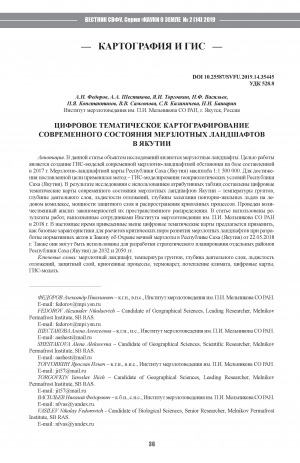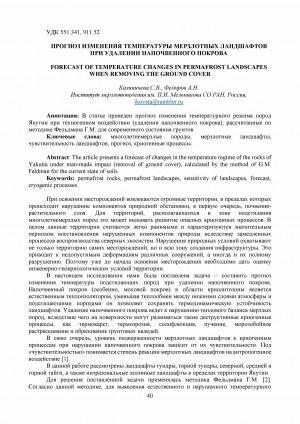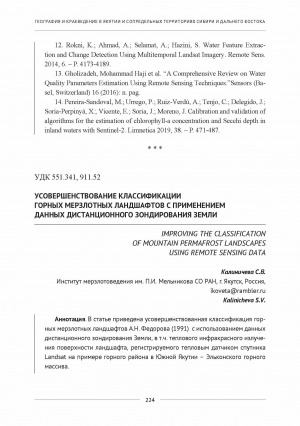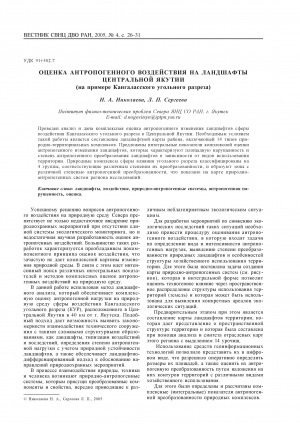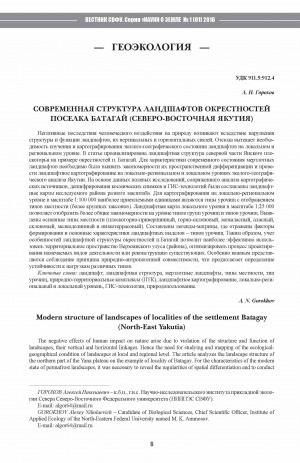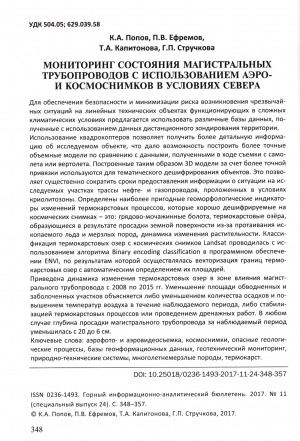
Оценка устойчивости мерзлотных ландшафтов Восточной Сибири (на примере Якутии) = Assessment of the permafrost landscapes stability in Eastern Siberia: the case of Yakutia
Статья в журнале
Русский
911.52:551.34(571.56)
10.25587/2587-8751-2024-3-51-59
многолетнемерзлые породы; мерзлотный ландшафт; льдистость пород; устойчивость ландшафтов; чувствительность поверхности; природно-территориальный комплекс; картографирование; техногенное воздействие; термокарст; термоэрозия; neotectonics; permafrost; permafrost landscape; ice content of ground; landscape stability; surface sensitivity; natural territorial complex; mapping; man-made impact; thermokarst; thermal erosion
The article provides an assessment of the stability of permafrost landscapes by two criteria: temperature and ice content of ground. The methods of assessing the stability of landscapes are presented: the Parmuzin scale, developed by him during the zoning of the north of Western Siberia by the potential possibility of thermokarst development and the Grave principle, on the basis of which a map scheme of the Yakut ASSR was previously compiled by the degree of surface sensitivity to technogenic impacts. Using the two presented methods of Parmuzin and Grave, based on the Permafrost-landscape map of the Republic of Sakha (Yakutia) on a scale of 1: 1,500,000, as well as maps of ground temperature of the Republic of Sakha (Yakutia) at the depth of the layer of annual fluctuations and ice content of surface deposits, landscape stability maps were compiled, the territory of Yakutia was divided into zones according to the degree of resistance to technogenic impacts. On the map compiled according to the Parmuzin method, landscapes according to the degree of resistance to technogenic impacts are differentiated into four gradations: unstable, relatively unstable, relatively stable and stable. Thus, according to this method, unstable landscapes occupy the smallest area of the study territory and are distributed mainly in the region with insular and discontinuous distribution of permafrost. Landscapes of the Central Yakut Plain, Prilenskoye Plateau and other lowlands with continuous permafrost distribution are characterized as relatively unstable. Relatively stable landscapes occupy the predominant part of Yakutia. Landscapes of mountainous regions are characterized as stable. According to the Grave method, landscapes on the map are divided into three gradations: relatively unstable, relatively stable and stable. According to the above-mentioned method, the territory of Central Yakutia, located in the area of highly icy soils and coastal arctic zones, is characterized as relatively unstable. The rest of the territory is assessed as relatively stable and stable.
Калиничева, С. В.
Оценка устойчивости мерзлотных ландшафтов Восточной Сибири (на примере Якутии) / С. В. Калиничева ; Институт мерзлотоведения им. П. И. Мельникова СО РАН // Вестник Северо-Восточного федерального университета им. М. К. Аммосова. Серия "Науки о Земле" - 2024. - N 3 (35). - C. 51-59. - DOI: 10.25587/2587-8751-2024-3-51-59
DOI: 10.25587/2587-8751-2024-3-51-59
- Краеведение. Археология. География. Биографии. История > Общие вопросы. География как наука. Географические исследования,
- Математика. Естественные науки > Общая геология . Метеорология. Климатология. Историческая геология. Стратиграфия. Палеогеография,
- НАУКА ЯКУТИИ > КРАЕВЕДЕНИЕ. ГЕОГРАФИЯ. БИОГРАФИИ. ИСТОРИЯ > Общие вопросы. География как наука. Географические исследования,
- НАУКА ЯКУТИИ > МАТЕМАТИКА. ЕСТЕСТВЕННЫЕ НАУКИ > Общая биология. Антропология. Вирусология. Микробиология.
Войдите в систему, чтобы открыть документ

